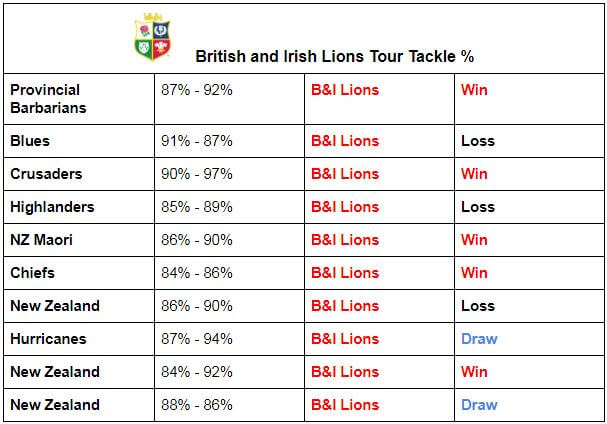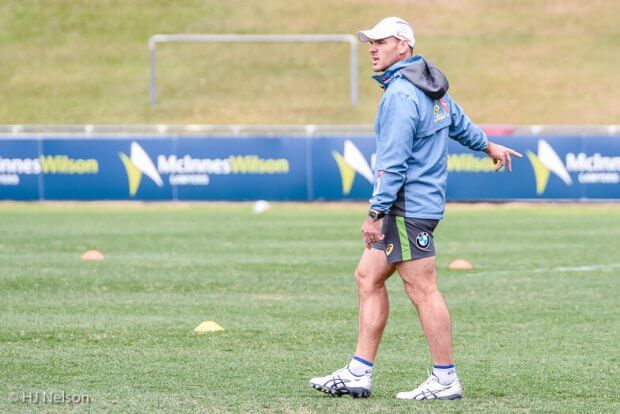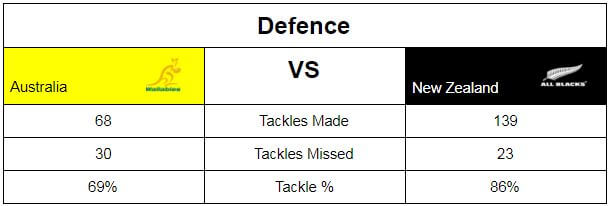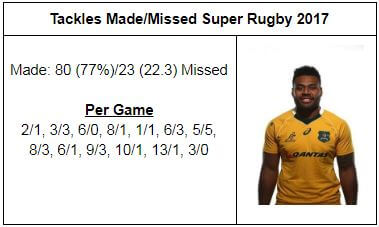As part of the fallout from the 1st Rugby Championship game its been interesting to hear the Australian coaching team talk.
Stephen Larkham – “I don’t think it was necessarily a poor performance, there were just too many errors”
It’s an interesting comment and in truth I get what Larkham is trying to say, that if they cut down the errors they’ll be there or there about. But that just doesn’t translate to what the paying public saw.
While there are many areas in which the Wallabies failed on Saturday, for me (and I’d imagine pretty much everyone else) defence was the biggest and most visible problem area of the game. We can talk all the attacking Rugby in the world, but its worth very little without a solid defence.
You can head to any park at the weekend and watch an afternoon footy match and the team that comes out on top is almost always one that makes its tackles. That’s obviously amplified at Elite level and when we get to International level unless you’re operating in the 80-90% range, as a minimum, you’re just not going to be in the game.
Let’s scoot back to the British & Irish Lions test series vs New Zealand. Were the B&I Lions lucky to get a drawn series? In hindsight probably, but whichever way we look at it that drawn series was built on solid defence. 92% tackle completion in test two, 86% in the second and in the 1st test which they lost it was 90% showing how tight the margins are.
In fact throughout that entire tour the highest difference in tackle % between the B&I Lions and any New Zealand team was a measly 8% in that same second test.

Simply put – get your defence sorted and you’re at least in with a semblance of a chance.
Of course, none of this is, or should be, news to anyone least of all the Wallabies, so when your post thrashing stats look like this:
You have to take a long hard look at yourself.
Individuals have come in for a lot of criticism for missing tackles but if your defence is posting a tackle success rate a full 17% below you’re opposition there is nowhere to hide that. A drop off rate approaching 20% to me says system error as opposed to individuals just not being up for it.
The fact of it is the Wallabies defensive system has absolutely failed and it comes down to what the Wallabies:
A: Prioritise Squad wise (Answer attack over defence)
B: What they ask their players to do within that defensive system.
Now the first is admirable, score more than your opponents and you’ll win and Cheika has always said they want to play good ball in hand footy. But you can score as many points as you want, it counts for very little if your opponents is scoring more than you.
Again all truisms, so none of this is particularly mind-shattering news to anyone let alone international coaches.
So what went wrong, or more importantly why did it go so wrong? It’s not that they aren’t brave guys to a man, it’s not that they are scared to tackle it’s that what is being asked of them in their defensive system is bordering on being completely and utterly bonkers.
If the best players are the ones who do the simple things well under pressure then the same holds true to the systems a team uses in a game. The simpler it is the easier to execute under pressure and the more effective it is, the more complex it is the harder to execute and the less effective it is.
New Zealand’s attack isn’t overly complex, it’s literally the same Rugby they’ve played since they were schoolboys, just executed at more pace, under more pressure and with refined skills. England and Ireland’s rush defence systems aren’t massively complex, they are just about setting early and getting in the oppositions face fast so they make bad decisions or decisions that favour your defence.
Australia’s defence is the complete opposite of that, it’s convoluted and if we look at the first half it’s abundantly clear players are confused with their roles.
Grey has an ideology, get the best defenders in the middle and the hide the weaker defenders away. We’ve seen it time and time again, mostly with the way the Wallabies and Waratahs keep hiding Foley out of harm’s way. How many times have you seen Horne step in and defend at 10 with Foley dropping to wing or as an auxiliary 15? Thinking Wallabies how often does Foley go to the defensive hooker position on opposition line-out with Hooper dropping out to 10?
It’s a clever idea, but the problem is at some point these players have to defend and while you can hide one player away you can’t hide two or three players as the Wallabies tried to on Saturday.
If we start at the beginning, with the opening kickoff it’s a perfect example of the system in use and the problem the complexity presents.
Foley kicks off, and Rona chases up on a wide channel whilst the kick off is collected on the far side of the pitch.
However the next wide shot we get, he’s gone. Like a ghost, he’s just disappeared. He’s not out wide, he’s not in tight he’s literally nowhere to be seen. There is just a vast yawning chasm of space and from the back field Foley is coming forward to fill in.
The Wallabies like to play with two fullbacks (left and right) that’s usually Foley and Folau. It makes sense, they shut down kicking options and both are fantastic counter attackers and have strong punts.
But Rona in the back three means Foley who, as the kicker, would usually drop into the 15 position now has to push up hard post kick to shutdown the space whilst a guy who has just pushed up on a kick chase now has to turn, run back and settle into a defensive 15 position.
Foley doesn’t really get there and doesn’t get off the line and the result is New Zealand attack there: Crotty beats Kerevi and the AB’s have dragged the Aussie Defence across and got in behind them.
As we can see on the next phase due to the speed of the ball transfer and the fact Crotty has got through the first tackle the transition defence hasn’t had time to set and the All Blacks go straight through, causing the Wallaby defence to fold in again.
Then off the next phase as they have the numbers on the defence they take it to the edge.
This time the Wallabies don’t know if they should push up, or drift out and as a result do neither. Speight hasn’t pushed up so they are able to isolate McMahon making him turn and Squire gets on his outside and eats up the yards.
Finally on the next phase we again see Foley defending the far edge of the defence and he’s hopelessly outnumbered and some poor passing coupled with a 50/50 offload from Williams halts the All Blacks momentum and gives Australia possesion.
This is a trend throughout so let’s jump on a few minutes and watch the Aussie defence again as New Zealand start to build an attack.
It starts with an easy turnover and NZ switch into attack mode, after a couple of phases we see the Australian defence is actually set up pretty good, 2 in the ruck, 11 in the line and 2 deep (Foley and Folau).
That’s on first glance, because New Zealand have a 4 vs 2 overlap on the far side and Australia with resources tied up in the ruck and the backfield can’t load both sides sufficiently. New Zealand drag the Australian defence to the far touch line.
The Wallabies drift and shut it down and while New Zealand are making easy yards if the Wallaby defence can set early on the next phase they should be able to get off the line quickly and put them under pressure.
Except Roana has again disappeared and this time he’s not been replaced by Foley, which means last man is Kerevi about 20m in.
Suddenly there is a narrow midfield with a massive overlap to New Zealand. Luckily for Australia New Zealand don’t see it and opt to punch up the middle ultimately winning a penalty.
Also if we watch how the Wallaby defence presses, you can see they are caught between two systems – line speed is generally poor but Arnold picks out a target and fires out the line, but no one steps in to finish the job behind him.
It’s just really passive defence caught between two systems.
Finally having won the penalty New Zealand chance the high kick and we see how heavily loaded that back field is considering the defence has been moving backwards at a rate of knots.
Finally let’s jump to the opening Try by Liam squire.
If there is one thing the last two years of Super Rugby has taught us it’s don’t give New Zealanders the chance to attack unstructured defence. So it’s kind of exasperating to see Foley simply kick the ball straight to the New Zealand back three, yeah it goes into touch but only just and it might as well have stayed infield for all the good it’s done in relieving pressure.
Obviously they go fast.
Additionally the kick chase is all over the place, Roana has come from left to midfield and Hooper has shot up with him but there isn’t really any 2nd wave of defenders coming up and McKenzie has a go, and gets the ball away to Crotty.
Also Watch Foley, he just stops.
Now Foley isn’t a lazy guy, he’s got a huge work rate in loose play but here it looks like he just doesn’t know what he’s supposed to do. He doesn’t track into a sweeper position; he doesn’t drop into the pocket for a potential kick return he just kind of stands there lost. You can almost see him thinking “what am I meant to be doing here again?”.
In fairness Australia Scramble but now as they set their defence we see a few things happen. The first is Kerevi is still getting back having tackled McKenzie and instead of just getting in the line on the far side he runs straight through the middle and then floats behind to get to the outer edge looking for a job rather than just making a decision and having an impact.
The second is that for no obvious reason the press comes up from inside to outside allowing the All Blacks to pass the ball reasonably easily to the edge of the defence.
Finally Kervei still not knowing where he’s meant to be just runs into Speights channel rather than taking the outside shoulder and helping out Foley who’s now got to defend a 2vs1 against Squire and Ioane the outcome is only ever going to be one way and Squire canters in from about 30m for a cracking try.
Startlingly we’re just over 10 minutes into the game and Australia haven’t put a solid defensive set in yet.
The first rule of creating a robust defence is get yourself in a position to defend.
That means:
- bodies in the line
- movement needs to be forward.
At that point you can decide if you’re going to drift or blitz.
All through this we can see Australia don’t really fill the line, don’t get off the line and they don’t really drift to shut down the wide space.
The end result is New Zealand are allowed to come forward transferring the ball under little pressure to where they can attack them.
To me swapping your defence around on the fly like this just makes no sense. It’s purely about one thing hiding weak defenders which while in theory is a great idea on paper is pretty hard to do in the flow of the game.
In fact all it’s done here is create a narrow defensive edge and left the wingers isolated and a defensive wall that doesn’t know if they should Blitz or drift. With Foley you can literally see him having to fight the instinct to drop back for the kick and force himself up into the line.
Why not just fill the line play out the initial defensive set and then get your players moved around on the next set piece?
Kerevi has come in for a lot of criticism and he’s a constant in the above examples, so is Roana and Foley.
It’s easy to look at them and ask the question what are they doing?
The answer is they don’t really know where they need to be, or what their defensive priorities are – is the first priority to fill the infield or set defensive width do they get off the line quickly or do they come up unified and drift out?
In the Squire try clearly Kerevi is thinking does he get across and cover Speight and Foley and in the end he just kind of does nothing
That’s not to defend Kerevi, he actually made 4 tackles and missed 4 tackles and was only on the field for 40 minutes.
I’m the first to say stats don’t paint the whole picture, and this isn’t about singling Kerevi out for special attention but the simple fact of it is if we look at his stats from the Super Rugby Season he’s got a 77% tackle rate which in truth isn’t awful but isn’t awe inspiring and if we look at individual game stats we can see that he’s not the most consistent of defenders anyway: stats per game for the season are as follows and that % is boosted by a couple of big defensive games:
So you have to question the coaches who would ask a hit and miss defender to anchor a complex defensive system in midfield that between them missed over half of the teams tackles (Beale 5, Kerevi 4, Speight 3, Rona 5). A midfield that returns 17 missed tackles against the All Blacks? It’s only going down one way.
But using Beale as an example shows us it’s doable, he has just come from a pretty successful season at Wasp’s. They topped the table and went to a final with some great attacking Rugby. They also got there with a defensive system that contained Danny Cipriani, Kurtley Beale, Christian Wade, Elliot Daly and Willie Le Roux.
On paper that’s a defensive liability, yet with clarity and a simple system that suited these guys (blitz) they ended up a reasonably solid defensive unit, not the best but certainly not the worst.
The key is it was a simple system and they all knew where they fitted in, and it gave them the best chance to either make their tackles or cause enough of a problem that the attack turned back in.
As a schoolboy I was taught if I can’t make a tackle then the next best thing is to push the attacker to someone who can. That’s a pretty simple concept to grasp.
We’ve seen in both Ireland and the B&I Lions the blueprint for pressuring New Zealand, an early defensive set and quick off the line – you’ll likely get them either coming back through the middle or going to the air but in both scenarios you create chances for your defence to get at their ball carriers/compete.
That doesn’t mean New Zealand won’t figure out how to beat it, but if Australia doesn’t start posing them problems they simply won’t have to.
Grey has expressed his disappointment in how they defended, he knows they let themselves down but ultimately the crux of it is Australia need to get back to basics and fast, simple Rugby where players know their roles and can consistently perform them.




